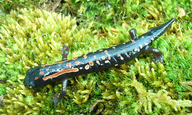|
Bolitoglossa lincolni (Stuart, 1943)
Subgenus: Magnadigita | family: Plethodontidae subfamily: Hemidactyliinae genus: Bolitoglossa |
 © 2006 Sean Michael Rovito (1 of 37) |
|
|
|
Description Distribution and Habitat Country distribution from AmphibiaWeb's database: Guatemala, Mexico
Life History, Abundance, Activity, and Special Behaviors Trends and Threats Possible reasons for amphibian decline Habitat modification from deforestation, or logging related activities Comments
References
Elias, P. (1984). ''Salamanders of the northwestern highlands of Guatemala.'' Contributions in Science, Natural History Museum of Los Angeles County, 348, 1-20. Raffaëlli, J. (2007). Les Urodèles du monde. Penclen Edition, France. Rovito, S., Parra-Olea, G., Vásquez-Almazán, C. R., Papenfuss, T. J., and Wake, D. B. (2009). ''Dramatic declines in neotropical salamander populations are an important part of the global amphibian crisis.'' Proceedings of the National Academy of Sciences of the United States of America, 106(9), 3231-3236. Stuart, S., Hoffmann, M., Chanson, J., Cox, N., Berridge, R., Ramani, P., Young, B. (eds) (2008). Threatened Amphibians of the World. Lynx Edicions, IUCN, and Conservation International, Barcelona, Spain; Gland, Switzerland; and Arlington, Virginia, USA. Wake, D. B., Lynch, J. F. (1976). ''The distribution, ecology, and evolutionary history of plethodontid salamanders in tropical America.'' Natural History Museum of Los Angeles County Science Bulletin, 25(1), 1-75. [link] Wake, D. B., Yang, S. Y., and Papenfuss, T. J. (1980). ''Natural hybridization and its evolutionary implications in Guatemalan plethodontid salamanders of the genus Bolitoglossa.'' Herpetologica, 36(4), 335-345. Wake, D. B., and Lynch, J. F. (1988). ''The taxonomic status of Bolitoglossa resplendens (Amphibia: Caudata) .'' Herpetologica, 44(1), 105-108. Originally submitted by: Kellie Whittaker (first posted 2009-03-15) Edited by: Kellie Whittaker (2009-03-15) Species Account Citation: AmphibiaWeb 2009 Bolitoglossa lincolni <https://amphibiaweb.org/species/3985> University of California, Berkeley, CA, USA. Accessed May 29, 2025.
Feedback or comments about this page.
Citation: AmphibiaWeb. 2025. <https://amphibiaweb.org> University of California, Berkeley, CA, USA. Accessed 29 May 2025. AmphibiaWeb's policy on data use. |




 Raffaëlli Account
Raffaëlli Account Map of Life
Map of Life